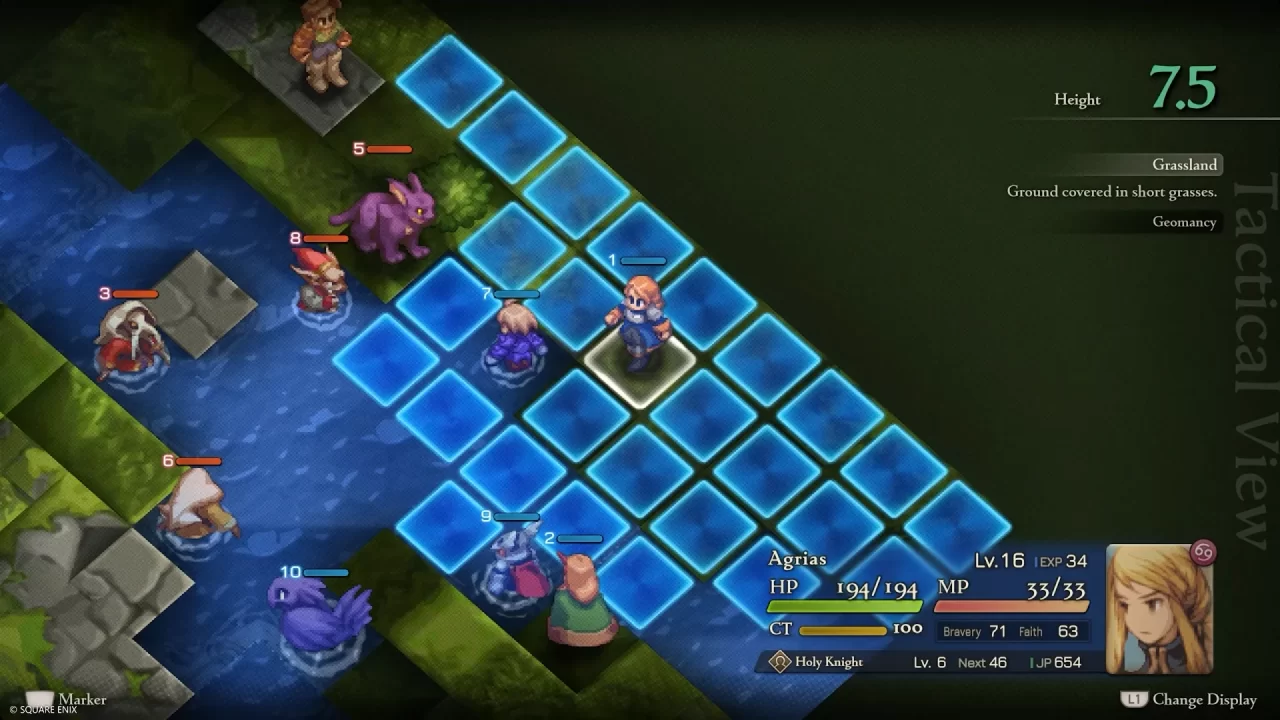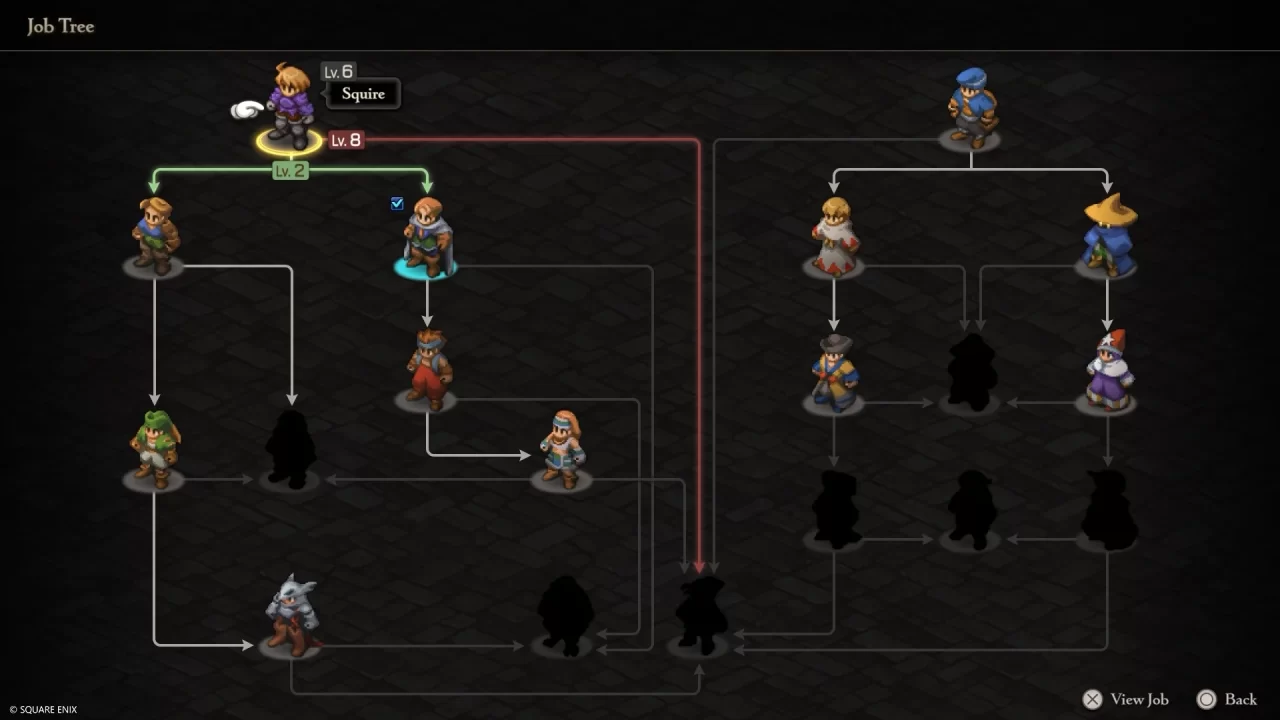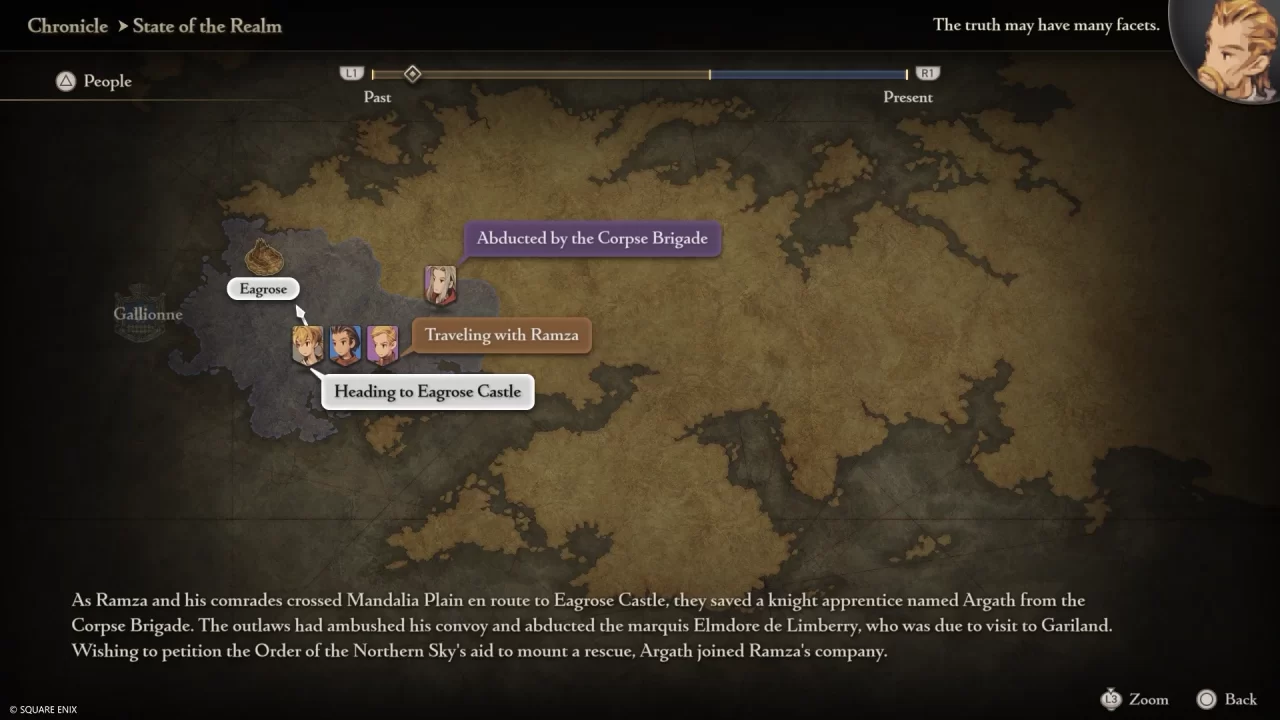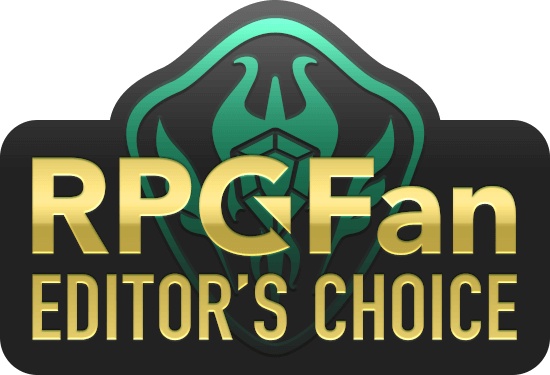Having a “favorite game of all time” can feel like a trite, tedious topic of conversation, especially amongst groups who spend a lot of time together. Most of my gamer friends know that I put Final Fantasy Tactics on a bit of a pedestal, though I know I’m not alone in this. I’ve done full playthroughs of this strategy RPG more than I have almost any other game, thanks to its gripping narrative, enthralling music, and highly customizable gameplay. One would assume the genre has moved forward since 1997 and this classic, while worthy of its place in history, has weathered over time. I am here to tell you: not so. Somehow, no game—that I’ve played, anyway—has surpassed FFT’s unbeatable combination of story, gameplay, and presentation. Now, we get to enjoy this timeless work of art with a fresh coat of paint, full voice acting, a rewritten script, and some adjustments to gameplay.
FFT follows Ramza Beoulve who, in present day, fights with a band of mercenaries doing odd jobs, though we learn immediately that he’s taken a fateful job involving a princess that somehow reconnects him with a childhood friend. After a well-constructed tutorial battle, we cut to a year earlier, wherein Ramza and dear friend Delita fight off bandits right outside their academy. Only squires learning how to become full knights, the two venture off to meet with Ramza’s father on his deathbed, as he has fallen ill. His father, a knight of legend from a war that lasted fifty years in this kingdom of Ivalice, shares precious words of encouragement with Ramza, who is nobility and carries a name with legacy of protecting the weak. As his older brother, Dycedarg, begins to lead the family, Ramza gets tasked with slaying rebels who resist the aristocracy and nobility. Alongside Delita, Ramza learns that the definition of “right” and “wrong” blurs for all, perhaps even himself.
The ensuing story continues like this with sophistry, moral greys, commentary about leaders and who writes history, and religion. All tightly compact with little clutter. While by no means a short game, FFT respects the players’ time with meaningful engagements and dialogue that drive the story forward while simultaneously characterizing the cast. With almost no humor or romance, FFT maintains its mission as a grim, serious narrative that defines what true heroism is.
I cannot think of one title that crisply, without waste, tells an epic narrative over years’ time and offers a weighty sense of place, atmosphere, and urgency from start to finish without relinquishing my attention. Japanese-style RPGs, like the rest of the Final Fantasy series, Dragon Quest, and the SNES and PS1 games of yore all have a certain feeling to them that marries light-heartedness with robust David-and-Goliath yarns emphasizing friendship. While many of them vary, the feeling they convey and tone remain largely consistent. Next, we have Western-style RPGs that favor dense, gruesome stories in worlds where living is akin to suffering. Prose goes on and on as grand, fantastical worlds appear on our screens, impress upon our minds, and are elaborated on seemingly endlessly. Then there’s FFT, which somehow blends these two feelings; it lacks the teenager-esque breeziness we get from JRPGs, but favors a sense of hope and drama we don’t typically encounter in WRPGs. In fact, that drama occurs as if on a stage as we hear poetry expressed through the lips of actors who seem to have waited their entire careers for this one script.
And I do mean poetry. The language here borders on melodramatic, but the weight of the War of the Lions, plight of the common folk, and unbridled arrogance of the nobility and church demand such intensity. Characters speak as if using a language akin to English with grammatical structure reminiscent of times long past. Words are used in ways no modern person speaks, yet the writing is almost always intelligible and rarely causes confusion. I consider myself as having a decent vocabulary and love of words, though there were times I heard a line spoken, read that sentence or two again, and still had no clue what the person said. I imagine folks who prefer grounded, concrete words may roll their eyes throughout, but for those who love flowery expressions and exchanges almost never stated plainly, the emotions evoked by each cast member ignited feelings I never felt before in the five or so times I completed this game.
I honestly can’t pick a stand-out performer here. The entire cast, including no-name passersby, absolutely kill their lines. While Ben Starr will earn accolades with his outstanding performance as Dycedarg, every other actor deserves as much—or more—recognition. Joe Pitts as Ramza acts as if playing five different characters as we witness Ramza grow from ignorant boyhood to angry outcast to bold hero. Timothy Watson’s Cidolfus expertly communicates as a not-too-old, grizzled knight of legend who stands by principles alone, yet simultaneously delivers terrifying lines during ability scripts in battle. Then there’s the guy at the poacher, who is easily the star of the show with the absolute creepshow he has no business putting out there in the universe.
Oh my God, I haven’t even talked about the gameplay yet. So, strategy RPGs take place on grids—usually squares—wherein characters take turns all proper-like before initiating attacks. In FFT, characters move on rotatable maps in isometric view as they get one action and one move. Most battles task players to eliminate all enemies, while some require meeting an objective or protecting one person. Place four or five of your characters on the battlefield and whack enemies, sling spells, and exploit auto-potion. (Because how else are you going to beat Tactician difficulty?)
Character customization is one of the best aspects of FFT, and something only executed as well in Fell Seal, which, let’s face it, was completely inspired by FFT. Each character, story-driven or no-name recruit, levels up to get stronger (as usual), but also accrues job points to develop their current job class. Jobs are exactly what you think they are: knight, white mage, black mage, dragoon, orator—you know, the basics. Over twenty basics, in fact. Each character not only learns abilities accrued through job points, but can adopt another job class as a sub-class, as well as equip reaction, support, and movement abilities. This means a character could potentially harness abilities from five different jobs, making experimentation an exhilarating prospect. Of course, some combinations are more intuitive than others, but don’t think it’s that simple, either. FFT, while a notoriously breakable game, has dozens of legitimate playstyles. Though, those daring enough to attempt Tactician mode may need to discover some of those aforementioned game-breaking strategies.
I played (most of) the game through Tactician difficulty, because after five playthroughs, I wanted a challenge. Yes, I employed some strong strategies I’ve learned over the years, but that seems required on Tactician. The original difficulty felt as if playing on easy mode. Then again, don’t expect any revolutionary game balancing or surprises on Tactician difficulty; for the most part, this feels like a numbers game, though I will say arithmeticks (math skill), as an example, was surprisingly nerfed on Tactician. Flip the switch to Knight (default difficulty), and you can cheese every battle in the game. Tip: think of arithmeticks more as a support tool than a damage cannon.
Going back to what makes FFT great: the maps! Several of the maps are so incredibly imaginative, as if painstakingly handcrafted to create a sense of place while simultaneously generating a strategic landscape. Height matters not just in terms of positioning and how characters can move, but also the range available when using abilities. Some abilities are irritatingly precise (looking at you, monks), while others are appealing simply for their flexibility. Do I surpass the cheaper job ability in favor of the more expensive, slower one simply because of its range and area of effect, or do I work up to it, forcing myself to build this character up more? Fortunately, grinding has never been easier.
I don’t like the word “grinding,” though, because it implies the battles aren’t fun. The battles are always fun. However, not everyone likes fighting battles for the sake of leveling, so in that case, the fast-forward feature on R1 makes leveling a breeze. What’s more, if you’re sick of fighting at Zeirchele Falls (why do I always get battles there?), you can simply choose the “flee” option on the world map to ditch the fight and move on with your life. You can also click your current node to generate a battle automatically, in case you’re hunting for rare fights (I still have never beaten the one at Barius Hill…) This also means that engaging in errands in towns is easy, because you can just bypass all of the random fights as you walk around spending days, waiting for your allies to get back.
Errands allow players to pull three no-name characters out of their party to engage in some mini-story (without you) and come back after eight to fifteen days. After returning, the characters talk about what a great success or failure the errand was, and provide some gil, which is plentiful even without errands. Sometimes, a rare trinket or wonder surfaces that has no in-game effect, but serves as a reference to other Final Fantasy games (think Matoya’s Cave as a lost wonder). Wink wink, nudge nudge, etc. For the fans.
Anyway, The Ivalice Chronicles introduces reading material, which players can actually read, but there are only a few of them. And—they’re not great. These books, while not poorly written, are poorly delivered. The scripts are hard to follow, and they frequently offer a basic choose-your-own-adventure style of minigame that is long and tedious. If you “win,” then you get a credits screen with the contributors of the book, and that’s it. These reading materials are truly for diehard fans, and even then, I can’t say they are worth my time. They only vaguely reference the FFT world, and the tone doesn’t match the game whatsoever.
Other furnishings I’ve noticed—or are openly publicized—in The Ivalice Chronicles include new visuals, rebalanced charge times and ability costs, and quality-of-life improvements regarding sidequests. While I find the visual “enhancements” a bit disappointing, I’m not sure what else they could have done without stripping FFT of its core identity. Further, I will say that I stopped caring about or noticing the visuals after a while, and they kinda fell to the background. Also, characters’ mouths move in dialogue, which, if you stare at it, is not great. I might even say terrible. I think you’re not supposed to be staring at the black line that widens and shrinks awkwardly—read the words along with the actor and take in the moving mouth with your peripheral vision; this actually enhanced my experience. I think.
Retooled charge times make classes like mages accessible and useful. Gone are the days in which black mages rely on Fire or maybe Fire 2 (now “Fira”) because higher-tier spells are impossible to cast before enemies act. This makes black mages way more powerful, even on Tactician difficulty. Further, powerful abilities, like Teleport, have increased job point costs to learn. Teleport, in particular, is a lot more. Like…a lot more. Frustrated with how to adopt <secret character>? Not anymore, because The Ivalice Chronicles painstakingly announces with a giant, bright blue marker where the next side quest is.
I could complain about how The Ivalice Chronicles doesn’t have a revamped soundtrack like we got with the Pixel Remasters, that the PSP content wasn’t included, or that it didn’t have new cinematics, but you know what? This is an outstanding remaster with a subtle touch to rebalancing that fans—and newcomers—will clamor for. Having Final Fantasy Tactics accessible on modern hardware with all the furnishings Square Enix was kind enough to bestow upon us—all I can say is “thank you.” In truth, while an updated soundtrack would have been my biggest ask, I still cannot believe how good this voice acting is. The localization team and actors have absolutely done us a service with this masterpiece, treating this title with the respect it deserves. This epic fantasy that tonally draws from different styles into one coherent, beautiful voice is available to all of us, and if communication from its creators is to be believed, we might see more of this world if we support Ivalice Chronicles. Do yourself a favor and enjoy what is, without question, one of the greatest tales ever told. One of the greatest RPGs ever created.








